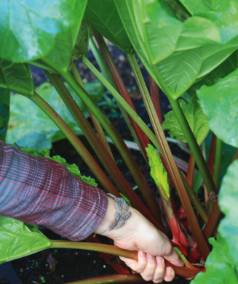How To Grow Rhubarb
Ever wondered How To Grow Rhubarb? Perhaps you already have it growing in your garden but are unsure on how to divide it or the best way to maintain it. Here is a guide on how to grow rhubarb as we think rhubarb is one plant that every vegetable garden should contain! It is easy to grow and hard to kill. It rarely has pest or disease issues and tastes amazing as crumble or pies!
Traditionally rhubarb was always grown by dividing an existing plant, so every plant grown is an identical clone of its parent. Today rhubarb can be grown from seed which often produces un-red stems and takes longer to grow. So the choice is yours, either grab some seeds, buy a crown ready to plant or talk nicely to someone with an established plant and take a crown from theirs.
Even though rhubarb is an amazingly easy plant to grow it does require some maintenance. Read on to find out exactly how to grow rhubarb.
How To Grow Rhubarb
1. When And Where To Grow

The ideal time to grow rhubarb is Autumn or Spring. Choose a sunny spot with well-draining soil, rhubarb will be ok in partial shade if need be. Rhubarb plants can get quite large so allow a spacing of 75cm (30″) between them.
2. Prepare The Soil

Rhubarb will grow in the same spot for a long time so it’s well worth preparing the soil properly before you plant it. Choose a sunny spot with well-draining soil. First, remove all weeds in the area you want to grow the rhubarb. A deep soil rich in organic manure is very important when growing rhubarb. Dig a big hole to around 76cm and add in plenty of well-rotted manure or compost to a depth of about 45cm (18”). Fill the remaining space with soil, to which blood and bone manure is added at the rate of a cupful to each bucket, plus a double handful of wood ashes. Click here to read more about preparing the soil.
3. Planting Crowns
When planting rhubarb crowns, set them so that the top of the crown sits 3cm (1″) below soil level. If you are gardening on a heavy, wet soil then plant them slightly higher, so that the top of the crown sits at ground level to help with rot prevention. Make sure you leave plenty of space, ideally 60- 120cm between plants in rows one metre apart.
4. Growing Rhubarb In Pots

It is possible to grow rhubarb in pots or containers however the pot must be large. Rhubarb plants have big root systems so containers must hold a minimum of 40 litres of compost to be sure of producing a decent crop. Plant in the same way as in the vegetable garden, with plenty of manure. Rhubarb will outgrow a pot so may need dividing earlier than in the garden.
5. Maintenance
Rhubarb grows well with little maintenance but will grow even better with a little care. Remove any flowers as they appear. Fertilise in spring. Water in dry weather. Apply a mulch of well-rotted manure around the crown of the plant in Autumn and lift and divide every 4-6 years. Rhubarb can be kept reproducing for generations if correctly maintained. Click here to read more about rhubarb maintenance.
6. Lifting And Dividing
It is ideal to lift and divide rhubarb crowns every 4 to 6 years as this will ensure that the plant remains productive. Dividing rhubarb plants should be done in the early spring as soon as the soil warms up enough to work it and prior to the emergence of the tender new shoots.To do this you will need a spade. Use the spade to dig around the root plant and lift from the ground. Divide the root ball into sections containing at least one but up to three buds with plenty of roots by cutting down through the crown between the buds. Any piece of rhizome with roots and at least one good bud will produce an identical plant to the parent. Replant each of these pieces separately or give them away to friends. Find more information about lifting and dividing here.
7. Harvesting
Although hard to resist, do not harvest rhubarb in its first year of growing. From the second year, you can pull each rhubarb stalk from the base of the stem and twist them away from the crown. Remember to never take more than half of the stems otherwise you may be left with an unhappy plant! Make sure you discard the leaves as they are toxic to eat but enjoy the stems cooked with sugar, in pies, tarts or even as a crumble. Read more about rhubarb here.

latest video
news via inbox
Nulla turp dis cursus. Integer liberos euismod pretium faucibua








